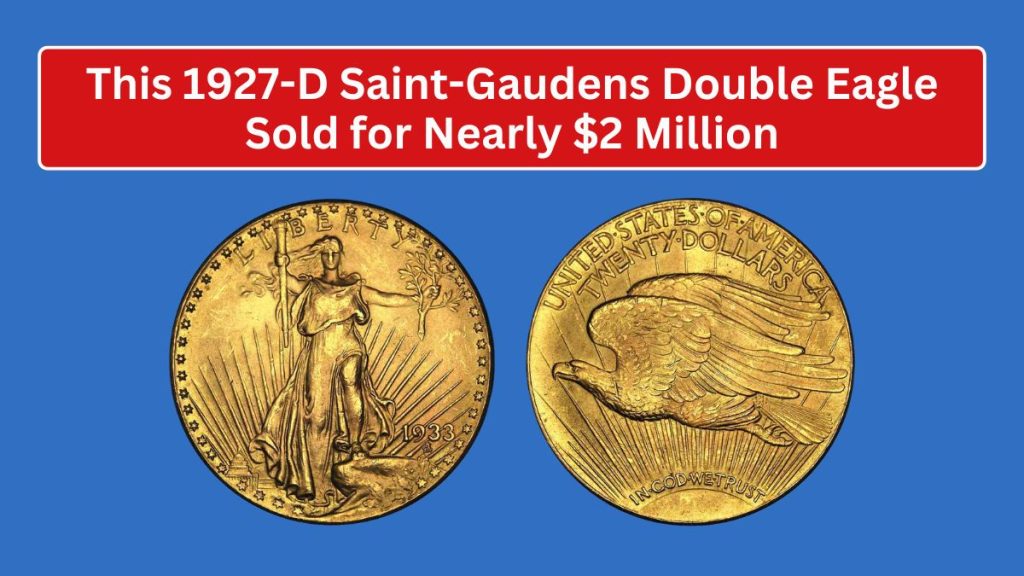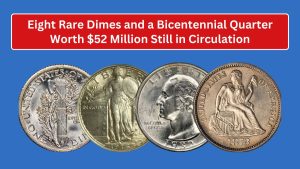The 1927-D Saint-Gaudens Double Eagle is one of the rarest and most coveted coins in U.S. numismatic history.
Recently, a specimen of this coin fetched nearly $2 million at auction, cementing its status as one of the most valuable coins in the world.
Collectors and investors alike are drawn to the coin’s rich history, scarcity, and exceptional design, created by the famous sculptor Augustus Saint-Gaudens.
History of the 1927-D Saint-Gaudens Double Eagle
The Saint-Gaudens Double Eagle, a $20 gold coin, was struck by the U.S. Mint from 1907 to 1933. Designed by Augustus Saint-Gaudens, the coin is widely considered one of the most beautiful ever produced by the U.S. Mint.
The coin’s obverse features Lady Liberty striding forward with a torch in one hand and an olive branch in the other, symbolizing progress and peace. The reverse showcases a majestic eagle flying over a rising sun.
The 1927-D Double Eagle was minted in Denver, with only 180,000 pieces struck. However, due to mass meltings of gold coins during the 1930s, most of the 1927-D coins were destroyed.
Today, it’s believed that only around 12 to 15 specimens still exist, making it one of the rarest regular-issue U.S. coins of the 20th century.
The Record-Breaking Sale
In recent years, the 1927-D Saint-Gaudens Double Eagle has consistently achieved impressive prices at auction. In 2024, one of these coins sold for nearly $2 million, making it one of the most expensive Double Eagles ever sold.
The coin’s rarity, historical significance, and impeccable condition contributed to its high value. Numismatists and investors alike are willing to pay a premium for this piece of American history.
Why Is It So Valuable?
Several factors contribute to the staggering value of the 1927-D Saint-Gaudens Double Eagle:
- Rarity: Only a handful of these coins survived the mass meltings of the 1930s. Some estimates suggest that only 12 to 15 specimens exist today.
- Condition: Many of the surviving coins are in mint-state (MS) condition, with grades ranging from MS-63 to MS-66. Coins in higher grades, such as MS-66, are particularly sought after.
- Historical Significance: As one of the last gold coins minted before the United States abandoned the gold standard in 1933, the 1927-D Double Eagle holds great historical importance.
- Design: The Saint-Gaudens Double Eagle is often regarded as the most beautiful coin ever produced by the U.S. Mint, further increasing its appeal to collectors.
Key Details and Auction Highlights
| Feature | Details |
|---|---|
| Mint | Denver (D) |
| Year of Minting | 1927 |
| Total Mintage | 180,000 |
| Estimated Surviving Coins | 12 to 15 |
| Recent Auction Price | Nearly $2 million |
| Designer | Augustus Saint-Gaudens |
| Obverse Design | Lady Liberty with torch and olive branch |
| Reverse Design | Flying eagle over the rising sun |
Historical Sales of the 1927-D Double Eagle
The 1927-D Double Eagle has a storied auction history, with prices steadily rising over the years. For instance:
- 1985: The coin sold for $275,000 at Stack’s auction.
- 2005: A specimen fetched $1.897 million at a Heritage Auction.
- 2024: One of the coins sold for nearly $2 million, reflecting its continued rise in value.
Counterfeit Concerns
Given its value, the 1927-D Saint-Gaudens Double Eagle has been the target of counterfeiters. In one notable case, a coin was submitted for grading with a fake “D” mintmark glued on, trying to pass off a Philadelphia-minted coin as a rare Denver version.
Experts at the Numismatic Guaranty Corporation (NGC) identified the forgery, highlighting the importance of third-party authentication for high-value coins.
The Legacy of the 1927-D Saint-Gaudens Double Eagle
The 1927-D Saint-Gaudens Double Eagle remains one of the most celebrated coins in numismatics. Its rarity, stunning design, and historical significance make it a prized possession for collectors and investors.
As long as demand for rare coins remains strong, the value of this iconic piece of American history is expected to continue rising.
Conclusion
The 1927-D Saint-Gaudens Double Eagle remains an icon in the world of numismatics, representing not just the pinnacle of U.S. coin design, but also a piece of history intertwined with the nation’s monetary policy.
With only a handful of surviving examples, this coin’s rarity and impeccable artistry contribute to its immense value, recently reaching nearly $2 million at auction.
As collectors and investors continue to seek out rare treasures, the allure of the 1927-D Double Eagle endures, ensuring its place among the most coveted and expensive coins in the world.
The story of this coin exemplifies the blend of artistry, history, and economics that can turn an ordinary item into an extraordinary symbol of wealth and prestige.
FAQs
1. Why is the 1927-D Saint-Gaudens Double Eagle so valuable?
The coin’s extreme rarity, with only around 12 to 15 known surviving examples, along with its historical significance and stunning design, make it highly valuable.
2. How much did the 1927-D Double Eagle sell for recently?
In 2024, a 1927-D Saint-Gaudens Double Eagle sold for nearly $2 million at auction.
3. What makes the Saint-Gaudens Double Eagle design special?
Designed by Augustus Saint-Gaudens, the coin is often hailed as the most beautiful U.S. coin ever minted, featuring Lady Liberty and a flying eagle.
4. How can I tell if a 1927-D Double Eagle is real?
Given the coin’s value, it’s essential to have it authenticated and graded by a reputable third-party service like NGC or PCGS to avoid counterfeit issues.
5. How many 1927-D Double Eagles are left?
It’s estimated that only 12 to 15 specimens remain in existence today.
References
- PCGS CoinFacts – Detailed information on the 1927-D Saint-Gaudens Double Eagle, including past sales and mintage data.
- CoinWeek – A comprehensive analysis of the 1927-D Double Eagle’s rarity and auction results.
- Wikipedia – Background on the Saint-Gaudens Double Eagle design and its historical significance.






